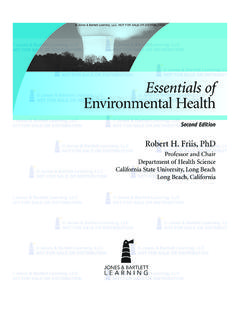Transcription of Employment essentials - Workplace policies and …
1 NSW Industrial Relations E M P L O Y M E N T E S S E N T I A L S Workplace policies and Procedures The need for effective Workplace policies and procedures has never been more important in today s changing Workplace . This is driven by changes to legisl ation, regulation and codes of practice. For example the recent changes to industrial relations legislation and the move to a national system have resulted in the emergence of Workplace issues of discrimination, Workplace rights and unfair dismissals that should be cover ed by effective policies . The Fair Work Act 2009 also has issues surr ounding various forms of leave entitlements. All organisations should have policies based on best Employment practices and ensure they comply with the new industrial relations system and meet minimum obligations. What is a Workplace policy? Workplace policies are statements of principles and practices dealing with the ongoing management and administration of the organisation.
2 policies act as a guiding frame of reference for how the organisation deals with everything from its day- to-day operational problems or how to respond to requirements to comply with legislation, regulation and codes of practice. It is important that policies are reasonable, that employees are aware and clearly understand what the policy is trying to achieve. policies are a statement of purpose, which highlight broad guidelines on action to be taken to achieve that purpose. The statement of purpose should not be more than one page in length, but this will vary depending on the policy. Procedures explain how to perform tasks and duties. A procedure may specify who in the organisation is responsible for particular tasks and activities, or how they should carr y out their duties. Benefits of Workplace policies Well-written Workplace policies : are consistent with the v alues of the organisation and Employment legislation demonstrate that the organisation is being operated in an efficient and businesslike manner ensure uniformity and consistency in decision- making and operational procedures save time when a new problem can be handled quickly and effectively through an existing policy foster stability and continuity maintain the direction of the organisation even during periods of change provide the framework for business planning assist in assessing performance and establishing accountability clarify functions and responsibilities.
3 NSW Industrial Relations Introducing Workplace policies What policies should I have in my Workplace ? The answer depends on the type of work and the business, but there are quite a few policies that every Workplace should have. A Code of Conduct sets standards of ethical conduct and Workplace behaviour that must be adhered to and can be added to or amended as needed. It can include issues such as personal and professional responsibilities and accountabilities in dealing with staff, colleagues and customers. It can also set standards for dress, grooming and appearance and the use of organisation s facilities and resources. Workplace policies should make reference to the possible consequences for breaches of the policy. Consequences may include an informal warning, a formal warning kept on the employee s file, or termination of Employment . A disciplinary policy is essential in outlining the process the employer will follow in issuing a warning, or in terminating Employment .
4 The disciplinary policy should clearly identify what behaviours may lead to the employee being dismissed without warning. See the Ending Employment card for more details of termination issues. Under the Fair Work Act, if an employee is sick while on a period of annual leave and they take paid sick leave, that leave will be deducted from their personal/carer s leave rather than their annual leave accrual. Best Employment practice dict ates that these situations should be covered by an appropri ate leave policy. The leave policy identifies the types of leave available and the process that must be followed to access the leave. It will also outline the evidence that is required as proof of illness or injury when claiming personal/carers leave and the circumstances that would require the evidence, for example a medical certificate as proof of personal illness or injury during a period of annual leave.
5 Workplace discrimination, bullying and harassment is an emerging Workplace issue. The Fair Work Act has provision for complaints to the Fair Work Ombudsman. Complaints are able to be investigated and in addition there is protection under state anti-discrimination legislation and human rights legislation. A good policy defines what constitutes Workplace discrimination, bullying and harassment, highlights the impact that this has on the individual, the organisation and society . A good discrimination, bullying and harassment policy has defined r eporting mechanisms, and is underpinned by a commitment to a safe and healthy Workplace free from discrimination, bullying and harassment. Developing policies It is crucial to have senior management support , especially where policies relate to employee behaviour. The endorsement and modelling of the behaviour by the CEO, senior managers and supervisors will encourage staff t o take the policies seriously.
6 The following steps help to ensure that your Workplace policies are successfully introduced and implemented in the Workplace : STEP 1 Planning and consultation Involve staff in developing and implementing Workplace policies to promote awareness, understanding, ownership and compliance. Staff i nvolvement also helps to determine how and when the policies might apply, including possible scenarios. Workplace policies and Procedures STEP 2 Research and define policy terms Research what a good policy looks like, see what other organisations are doing and use a variety of sourc es that acknowledge contemporary Workplace issues. Be explicit. Define key terms used in the policy so that employees understand what is meant. The policy should explain what is acceptable and unacceptable behaviour in the Workplace . You may wish to include specific e xamples to illustrate problem areas or unacceptable types of behaviours.
7 Be clear about who the policy applies to. For example, does it only apply to employees of the company or to contractors and sub-contractors engaged to perform work on business premises? The policy may also need to contain information about what to do if it is not possible to follow the policy. For example, if you have a policy relating to punctuality , you may need to include a procedure outlining what to do if the employee is going to be late. Example: Occupational health and safety No employee is to commence work, or return to work while under the influence of alcohol or drugs. A breach of this policy is grounds for disciplinary action, up to and including termination of Employment . Example: Email policy Using the organisation s computer resourc es to seek out, access or send any mater ial of an offensive, obscene or defamatory nature is prohibited and may result in disciplinary action up to and including termination of Employment .
8 STEP 3 Draft policy policies should be written in plain English and easily understood by all employees. Consider translating the policies into appropri ate languages for employees whose first language is not English. Ensure all employees understand what the policies mean. Explain how to comply with the policies and the implications of not complying. Agree on a format to be used and seek comments and feedback. Review, revise and recirculate the policy on a regular basis. STEP 4 Implementation To be effective, policies need to be publicised and provided to all existing and new employees. The policies may be explained to employees through information and training sessions, at employees meetings and during induction. policies should also be reite rated and discussed regularly to ensure they remain relevant. Copies of policies should be easily accessible. Copies may be kept in folders, policy manuals and available on the organisation s intranet system.
9 STEP 5 Compliance It is important that policies apply consistently throughout the organisation. A breach of a policy should be dealt with promptly and according to the procedures set out in the policy. The consequence of the breach should also suit the severity of the breach whether it be a warning, disciplinary action or summary dismissal. A termination/disciplinary policy should set out what the organisation considers to be serious, willful or gross misconduct , for example a breach of a confidentiality policy. Review policies regularly to ensure they are current and in line with changes within the organisation. Where policies are significantly changed they should be re-issued to staff and the changes explained to ensure staff understand the organisation s new directions. These changes should also be widely publicised. Case study An organisation which dismissed an employee for sexual harassment was subsequently ordered to re-employ the sacked staff member as they had failed to follow their own policy.
10 The company had a policy of zero tolerance to sexual harassment but failed to exercise the provision when the policy was breached. The Commission hearing revealed that the company had breached its own policy when it issued the employee numerous unofficial warnings instead. Other titles in the Employment essentials series Ending Employment Introducing Workplace Flexibility Managing People Managing Performance To find out information about the NSW Industrial Relations' workshop and webinar program, contact NSW Industrial Relations Employer Education Services. NSW Industrial Relations Email: NSW IR Workshops at Telephone: (02) 9228 5986 or follow NSW_IR on T witter Supporting fair and productive workplaces. Disclaimer: This publication is intended to be a general guide only. All due care has been taken in its preparation, and the information is believed to be current at the date of publication.






